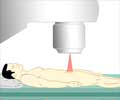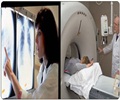Early stage lung cancer treatment for patients who cannot be operated showed better outcome with radiotherapy if they had adenocarcinoma type of cancer vs squamous cell cancer.
- The effect of stereotactic body radiation therapy (SBRT) on different types of lung cancer was studied by scientists from the Cleveland Clinic.
- Squamous cell carcinoma patients had two times the risk of local failure after SBRT when compared to patients with adenocarcinoma.
- These findings can be used to optimize treatment for lung cancer patients based on the cells of origin.
Lung Cancer
Lung cancer is the most common form of cancer and is the most common cause of cancer-related death in the world.- It accounts for 13% of all new cancer cases worldwide
- It accounts for 19% of cancer-related death in the world
- About 1.8 million new lung cancer patients were detected in 2012
- Lung cancer constitutes 6.9% of all new cancer cases in India
- It constitutes 9.3% of all cancer-related death in India
- It is the most common form of cancer and cancer-related death among men
- In India, Mizoram has the highest incidence of lung cancer
- Non-Small Cell Lung Cancer (NSCL)- 80-85% of lung cancer falls under this category.
- Small Cell Lung Cancer - constitutes 10-15% of lung cancer
- Squamous cell carcinoma
Treatment for Lung Cancer
Surgery is considered during the early stages of lung cancer (stage I and II). However, surgery may not be possible always and depends on -- Age of the patient
- Medical co-morbidity
- Location of the tumor
Scientists from Cleveland Clinic, U.S, analyzed 740 patients who underwent SBRT during the period 2003 to 2015 to identify the impact of histological subtype and heterogeneity of the tumor on SBRT treatment outcomes.
The patients were grouped into 4 categories
- Adenocarcinoma-32%
- Squamous cell carcinoma-29%
- Unknown- These included people who did not have a biopsy-30%
- Non-small cell lung cancer-8%
When multivariate analysis was used to calculate the strongest predictor of local failure, it was found that squamous cell carcinoma histological subtype was the strongest predictor at a rate that was significantly higher than people with adenocarcinomas.
This is one of the first studies that analyzed the effect of SBRT on histological sub-types of cancer, according to the authors. Squamous cell carcinomas had a higher rate of failure than other types of NSCLC. The study found that the local failure of squamous cell carcinoma was two fold higher than adenocarcinoma.
SBRT is a radiation therapy that is used for tumors outside the central nervous system. In this treatment procedure, a specialized co-ordination system is used for the exact localization of the tumors in the body. Ether a single high dose radiation treatment is delivered or a few fractionated treatment procedures are administered.
SBRT is administered for those cancers that are not easily accessible or are present in underlying tissues. The current study evaluated the benefit of using SBRT on the different types of non-small cell lung cancer, which is the first study on the difference in outcome based on histological differences. The study found conclusively that adenocarcinomas had a two time lower risk of local failure when treated with SBRT when compared with squamous cell carcinoma.
The study can be used to optimize treatment for non-small cell lung cancer based on histological origins of the cancer.
References:
- Lung cancer: Prevalent trends & emerging concepts - (https://www.ncbi.nlm.nih.gov/pmc/articles/PMC4405940/)
- What Is Lung Cancer - Non-Small Cell? Topics - (http://www.cancer.org/cancer/lungcancer-non-smallcell/detailedguide/non-small-cell-lung-cancer-what-is-non-small-cell-lung-cancer)















